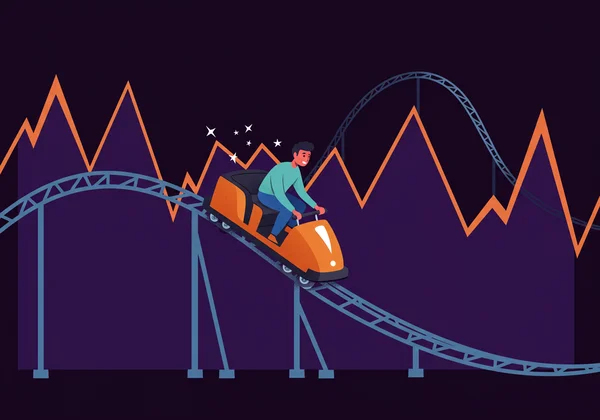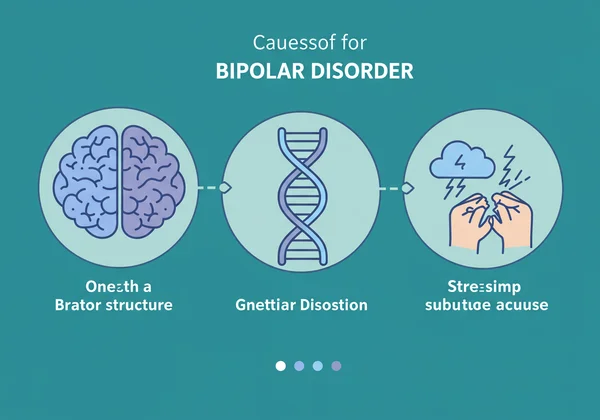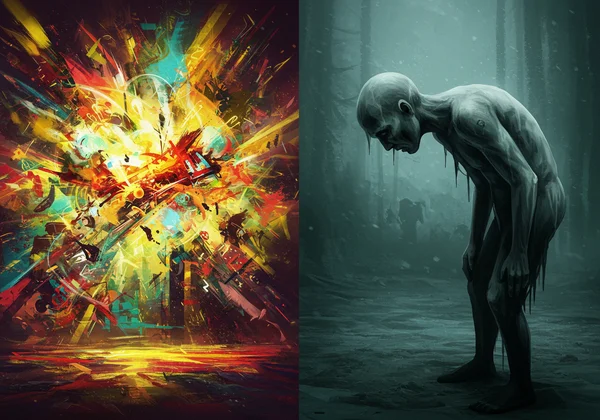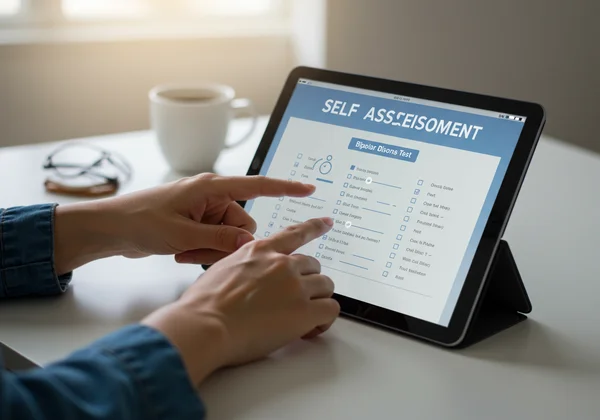Bipolar Test & Disorder Guide: Symptoms, Types & Self-Assessment
Ever feel like your moods are on an unpredictable roller coaster, impacting every aspect of your life? You're not alone. The journey of understanding your emotional health can feel complex, but gaining clarity is the first powerful step toward stability. What is bipolar disorder? This comprehensive guide will demystify the condition, exploring its symptoms, types, and the initial steps you can take toward understanding your own experiences. This is a journey of self-awareness, and it starts with knowledge.
If these patterns feel familiar, a structured self-assessment can be a helpful starting point. You can explore our test for a preliminary look at your mood patterns.
Understanding Bipolar Disorder: More Than Just Mood Swings
Many people experience mood fluctuations, but bipolar disorder is distinct. It is a mental health condition characterized by extreme shifts in mood, energy, activity levels, and concentration. These shifts can range from periods of intense excitement and energy, known as manic or hypomanic episodes, to periods of deep sadness and hopelessness, known as depressive episodes.
These are not the typical ups and downs that most people experience. The mood episodes in bipolar disorder are intense, can last for days or weeks, and can significantly interfere with a person's ability to carry out daily tasks, manage relationships, and maintain work or school commitments. Recognizing it as a legitimate medical condition is crucial for reducing stigma and encouraging people to seek help.

Defining Bipolar Spectrum Disorder: A Clinical Overview
Clinicians often refer to the "bipolar spectrum" because the condition manifests in various ways. It's not a single, one-size-fits-all diagnosis. The spectrum includes Bipolar I, Bipolar II, and Cyclothymic Disorder, each with unique criteria based on the severity and duration of mood episodes. Thinking of it as a spectrum helps capture the diverse experiences of individuals and leads to more nuanced understanding and treatment. This approach acknowledges that everyone's journey is different.
What Causes Bipolar Disorder? Exploring Risk Factors
While the exact cause of bipolar disorder is unknown, researchers believe a combination of factors contributes to its development. There is a strong genetic component, meaning it often runs in families. A person with a parent or sibling with bipolar disorder has an increased risk of developing it themselves.
Brain structure and chemistry also play a significant role. Imbalances in naturally occurring brain chemicals called neurotransmitters are thought to contribute to the mood episodes. Furthermore, highly stressful events, trauma, or substance abuse can sometimes trigger the onset of symptoms in individuals who are already genetically predisposed to the condition.

Recognizing the Signs: Key Bipolar Disorder Symptoms
Identifying the symptoms is the first step toward getting help. The signs of bipolar disorder are categorized by the type of mood episode a person is experiencing—manic, hypomanic, or depressive. These episodes are distinct periods of unusual mood and behavior.
It is the pattern and intensity of these episodes that define the diagnosis. Understanding these different states is essential for both individuals and their loved ones to recognize when something is more than just a passing mood. A free bipolar test can help organize these observations.
The Euphoric & Energetic Highs: Mania and Hypomania
Mania and hypomania are periods of elevated or irritable mood, accompanied by a significant increase in energy and activity. The main difference between them is severity. Mania is more severe, causes significant impairment in daily functioning, and may include psychotic symptoms or require hospitalization. Hypomania is a less severe form that doesn't cause major disruptions in work or social life.
Common signs of mania and hypomania include:
- Feeling unusually "high," euphoric, or extremely irritable.
- Decreased need for sleep while still feeling energetic.
- Increased talkativeness or feeling pressure to keep talking.
- Racing thoughts or flight of ideas.
- Being easily distracted.
- An increase in goal-directed activity (at work, school, or socially).
- Engaging in risky behaviors with high potential for painful consequences (e.g., spending sprees, impulsive decisions).
The Depressive Lows: Understanding Bipolar Depression
A major depressive episode in the context of bipolar disorder involves a period of profound sadness, loss of interest, and other emotional and physical problems. To be diagnosed, these symptoms must be present for at least two weeks. It can often be difficult to distinguish bipolar depression from major depressive disorder without observing a history of mania or hypomania.
Symptoms of a depressive episode include:
-
Persistent sad, anxious, or "empty" mood.
-
Feelings of hopelessness or pessimism.
-
Loss of interest or pleasure in activities once enjoyed.
-
Fatigue or decreased energy.
-
Difficulty concentrating, remembering, or making decisions.
-
Changes in sleep patterns (sleeping too much or too little).
-
Changes in appetite and/or weight.
-
Thoughts of death or suicide.

Other Common Symptoms & How They Impact Life
Beyond the core mood episodes, individuals with bipolar disorder may experience other symptoms. Mixed episodes, where symptoms of both mania and depression occur simultaneously or in rapid sequence, can be particularly confusing and distressing. Anxiety is also a common co-occurring condition.
These symptoms can profoundly impact every area of life. Relationships can become strained due to unpredictable behavior and mood shifts. Work or academic performance can suffer, leading to job loss or academic failure. The impulsivity associated with manic episodes can lead to severe financial or legal trouble, making stability a constant challenge.
Exploring Bipolar Types: Differentiating Bipolar I, II, and Cyclothymia
Understanding the different types of bipolar disorder is crucial for accurate diagnosis and effective treatment. The primary distinctions are based on the presence and severity of manic episodes. Each type represents a different point on the bipolar spectrum.
Bipolar I Disorder: Defining Manic Episodes
Bipolar I Disorder is defined by the occurrence of at least one full manic episode. This manic episode must last for at least one week or be severe enough to require hospitalization. Individuals with Bipolar I often experience hypomanic or major depressive episodes as well, but the presence of a full manic episode is the key diagnostic criterion. This is often considered the most severe form due to the intensity of the manic phases.
Bipolar II Disorder: The Hypomanic Experience
Bipolar II Disorder is characterized by a pattern of at least one major depressive episode and at least one hypomanic episode. Importantly, individuals with Bipolar II have never had a full manic episode. Because hypomania can feel productive or energizing, it sometimes goes unrecognized, leading many people with Bipolar II to seek help only for their depressive symptoms, which can lead to misdiagnosis.
Cyclothymic Disorder & Other Specified Bipolar Conditions
Cyclothymic Disorder, or cyclothymia, is a milder form on the bipolar spectrum. It is defined by numerous periods of hypomanic symptoms and periods of depressive symptoms lasting for at least two years (one year in children and adolescents). However, the symptoms do not meet the full criteria for a hypomanic or depressive episode. "Other Specified Bipolar and Related Disorders" is a category used when symptoms don't fit neatly into the other types but still cause significant distress.
Seeking Clarity: The Path to Diagnosis and Professional Help
If you suspect you may have bipolar disorder, the path to clarity begins with seeking professional help. A formal diagnosis can only be made by a qualified healthcare provider, such as a psychiatrist or psychologist.
The Professional Diagnostic Process: What to Expect
A professional diagnosis typically involves a comprehensive evaluation. A healthcare provider will conduct a psychological interview to discuss your symptoms, experiences, and family history. They may ask you to track your moods over time and will rule out other medical conditions that could be causing your symptoms. There is no blood test for bipolar disorder; diagnosis is based on your reported symptoms and behavioral patterns.
Why a Self-Assessment Can Help: Your First Step with our bipolar test
While not a substitute for a professional diagnosis, a self-assessment can be an invaluable first step. Using a tool based on established screening questionnaires, like the Mood Disorder Questionnaire (MDQ), can help you organize your thoughts and identify patterns in your moods. Taking a preliminary screening tool can provide structured insights that make the conversation with a doctor more focused and productive. It empowers you with information to begin your journey toward clarity.

Preparing for Your Doctor's Appointment
When you decide to see a doctor, being prepared can make the appointment more effective. Write down your key symptoms, including when they started and how they impact your life. Make a list of any medications you are taking and any family history of mental health conditions. Bringing the results from an online screening can also provide a useful summary to share.
Living with Bipolar Disorder: Treatment, Support & Well-being
Living with bipolar disorder presents challenges, but with the right treatment and support, it is entirely possible to lead a full and stable life. Management is a long-term journey focused on minimizing the impact of mood episodes and maximizing well-being.
Comprehensive Treatment Approaches: Therapy & Medication
Effective treatment for bipolar disorder typically involves a combination of medication and psychotherapy. Mood stabilizers are often prescribed to control manic or hypomanic episodes. Psychotherapy, such as Cognitive Behavioral Therapy (CBT), can help individuals identify and change troubling thoughts and behaviors, learn coping strategies, and improve relationships.
Building a Support System: For Individuals and Loved Ones
A strong support system is vital. This includes friends, family, and support groups where you can share experiences with others who understand. For loved ones, educating themselves about the condition is one of the best ways to provide meaningful support. Understanding triggers and symptoms can help them respond with empathy and effectiveness.
Lifestyle Strategies for Managing Moods and Promoting Stability
Beyond professional treatment, certain lifestyle strategies can help manage symptoms. Maintaining a regular routine for sleep, diet, and exercise is fundamental for mood stability. Learning to recognize the early warning signs of an impending mood episode can allow you to seek help before it becomes severe. Stress-management techniques like mindfulness and meditation can also be highly beneficial.

Empowering Your Journey: Take the Next Step
Navigating the complexities of bipolar disorder can feel overwhelming, but understanding is your most powerful tool. This guide has equipped you with foundational knowledge about its symptoms, types, and the initial steps toward clarity. Remember, self-awareness is the beginning of a journey towards stability and well-being.
If you suspect you or a loved one might be experiencing these symptoms, taking the first step is crucial. Our free, confidential Bipolar Test offers instant insights and an optional AI personalized report to help you better understand your mood patterns. It is a stepping stone, not a diagnosis, but it can provide valuable information to share with a mental health professional. Are you ready to get instant insights?
Disclaimer: This content is for informational purposes only and does not constitute medical advice. It is not a substitute for professional medical advice, diagnosis, or treatment. Always seek the advice of your physician or another qualified health provider with any questions you may have regarding a medical condition.
Frequently Asked Questions About Bipolar Disorder
How can I know if I might have bipolar disorder?
The key is recognizing patterns of extreme mood shifts that are a significant change from your usual self. If you experience distinct periods of elevated energy and mood (mania/hypomania) alternating with periods of deep depression that disrupt your life, it's a sign to explore further. A good first step is to document your symptoms and then take a self-assessment to structure your concerns before speaking with a professional.
What are the early signs of bipolar disorder?
Early signs can be subtle and often appear during the teenage or early adult years. They might include significant mood swings, periods of high energy and irritability followed by withdrawal and sadness, changes in sleep patterns, and impulsive behavior. These signs can sometimes be mistaken for normal adolescent turmoil, which is why paying attention to the severity and pattern is important.
Is it just moodiness, or could it be bipolar disorder?
Everyone experiences moodiness, but the mood shifts in bipolar disorder are more extreme, last longer, and interfere with daily functioning. While a bad mood might last a few hours, a depressive episode lasts for at least two weeks. Similarly, the "highs" of bipolar disorder are more intense and disruptive than simply feeling happy or excited.
What is the main difference between Bipolar I and Bipolar II?
The primary difference lies in the severity of the elevated mood episodes. Bipolar I is defined by the presence of at least one full manic episode, which is a severe mood disturbance. Bipolar II is characterized by less intense elevated moods called hypomania, along with at least one major depressive episode. Individuals with Bipolar II never experience a full manic episode.
What are the risks of leaving bipolar disorder untreated?
Left untreated, bipolar disorder can lead to serious problems that affect every aspect of life. These include damaged relationships, poor job or school performance, financial and legal troubles, and co-occurring issues like substance abuse. The risk of suicide is also significantly higher in individuals with untreated bipolar disorder, making early diagnosis and consistent treatment critically important.